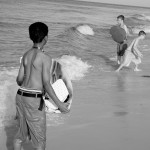 When I watch my children skim-boarding in the surf, I remember what it is like to be blissfully young, oblivious to danger, and as flexible as a rubber band. I am none of those things now. That is why you will not catch me performing very many “ollies” or “shuv-its” on the beach. For my children, skim-boarding is a gnarly good time. But for me, it is a nothing but an extended, unbridled, fall that more resembles a hydroplaning hatchback than an act of athleticism.
When I watch my children skim-boarding in the surf, I remember what it is like to be blissfully young, oblivious to danger, and as flexible as a rubber band. I am none of those things now. That is why you will not catch me performing very many “ollies” or “shuv-its” on the beach. For my children, skim-boarding is a gnarly good time. But for me, it is a nothing but an extended, unbridled, fall that more resembles a hydroplaning hatchback than an act of athleticism.
Plus, I haven’t forgotten my time as a chaplain in a beachside Emergency Room. Moms, dads and grandparents were hauled in to the welcoming arms of the orthopedic surgeons by the ambulance-full. I prayed over more than a few broken ankles, wrists, and collarbones of well-meaning middle-agers who were only trying to keep up with their kids. Now, the youngsters have their own share of pain and suffering from this sport. Mine certainly do. They fall, sometimes very hard, barely able to bounce back to their feet. But rise they do, leaving the beach carrying their skim-boards and more goose eggs, bruises, zings, and sand rash than should be on a human body.
It begs the obvious questions: How can anything that hurts so badly be worth it? How can something so painful, be so much fun? But it is fun, not because there is no danger, but because after each fall they get up and try again to master the board and the water; something I’m not willing to do. Truth be told, getting up and getting on with it after you fall might be one of the most defiant acts possible, and the real secret of a joyful life. There is no shame in falling down, none. The test of our mettle is whether or not we get up to try again.
Malcolm Gladwell has written a fantastic little book called “Outliers.” In it, he operates with the hypothesis that the most successful people are not those who are simply born with great ability. Rather, success is dictated more by environment, community, and some very hard work. Gladwell proposes the 10,000 hour rule. He states that mastery of a subject – any subject – is not possible until the student has put in 10,000 hours of disciplined, dedicated practice. This applies, according to Gladwell, to everything from playing hockey to skim-boarding, from the Beatles to Beethoven.
For context, 10,000 hours is roughly twenty hours of practice and performance each week for a decade. In other words, it takes more than ability. It takes the tenacity to get up off the sand, get back on the board, and keep trying – even when it hurts. The Apostle Paul knew a little about pain. In an autobiographical sketch detailing some of his hard times, he wrote about being beaten with rods, nearly stoned to death, and suffering shipwreck. He was victimized by robbery, legal troubles, imprisonment, sleeplessness, starvation, his own poor health, and the regular pressures of being a human being. And why did he suffer these injustices? Simply because of his faith.
Yet, he was the same writer – the same person – to say, “Don’t give up in the hard times. Good things come to those who don’t lose heart.” Hard times and hard falls come to us all. Anyone who has ever stepped onto a skim-board knows that. But what we do with those hard times, those hard falls that knock the breath from our lungs and plant our faces in the surf, that makes all the difference. Like me, we can step away and never try again, and thus never enjoy again. Or like joyful children, we can get up in scorn of the pain, and stay at it.
Joy is not always something that spontaneously arrives, like an unearned, unexpected gift. It is the product of hard work, a few broken bones, and your own share of cuts and bruises. But to stay with something that matters – really matters – is to be rewarded with a joy that is unspeakable and full of glory.

